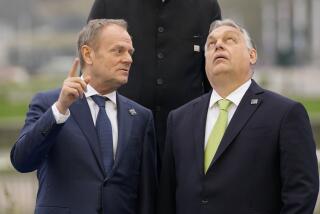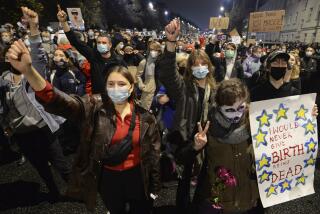Russia’s Woes Bring Asia Crisis to East Europe
- Share via
WARSAW — The Asian economic crisis, by contributing to Russia’s recent financial upheavals, has now hit Eastern Europe.
While Poland, Hungary and the Czech Republic have only modest trade ties to East Asia, they are guilty by association as emerging markets. And the Russian crisis threatens to cut directly into these countries’ exports.
Economic growth remains fairly robust in Poland and Hungary. But the entire region is being hit by the flight of capital as foreign fund managers pull money out of East European markets to raise cash to cover losses in Russia or to pay back investors bailing out of Russian markets.
As a result, key stock markets in recent days have tumbled to their lowest levels in many months, currencies have been weakening, and government leaders are worried.
“I think there’s going to be a short-term impact. The currencies and the markets will be jolted. But the fundamentals of Poland, Hungary and the Czech Republic look good in the medium term,” said a London-based analyst monitoring Eastern Europe, who spoke on the condition that he not be further identified.
While East European markets rose modestly Tuesday along with other world exchanges, they have fallen sharply in recent days. In Hungary, the Budapest Stock Exchange’s BUX index is down 16% for the year. The benchmark WIG index of Warsaw’s stock exchange is off 3.2%, Prague’s PX 50 index is down about 11%, and Slovakia’s benchmark SAX index has fallen 38%.
Regional currencies have also been tumbling. The Hungarian forint hit a record low against the dollar Monday, and the Polish zloty has sharply lost value in recent days.
The impact on this region’s financial markets from Asia’s troubles has been building since last year.
“We are regarded as an emerging market together with these Asian markets,” said Judit Barta, a GKI Economic Research analyst in Budapest. “I think investors lost their enthusiasm for emerging markets, and you could see it here in Hungary as well. Everywhere, money flew back from emerging markets to more secure markets.”
In terms of the “real economy”--manufacturing, trade, employment--countries of this region are among those most nearly protected against Asia’s woes. None of the East European nations sends as much as 3% of its exports to East Asia.
“The Asian crisis has a very limited [direct] influence on the Polish economy because our trade with the countries of that region is very small,” said Jozef Biskup, an economist in Warsaw at the Institute of Economic Trends and Prices in Foreign Trade.
But the economies of Eastern Europe are far more vulnerable to Russia’s problems.
Economies Linked in Markets, Minds
Back in the days of Communist rule and planned economies, the former Soviet Union was a far bigger export market for Eastern Europe than Russia is today. But the Russian market retains major and growing importance for this region’s economies. They also are linked with Russia in emerging-market investment funds and in the psychology of foreign investors.
Last year, Hungary sent 9.5% of its exports to Russia, nearly double the previous year. Poland sent 8.2% of its exports to Russia during the first five months of this year, compared with 7.4% last year and 6.8% in 1996.
Russia’s anemic ruble will shrink that country’s ability to buy those exports, threatening production and jobs.
This linkage with Russia can push the region’s markets up as well as down. For example, when the International Monetary Fund agreed in early July to grant a $14.8-billion loan to Russia, that prompted surges in East European markets--gains that were quickly lost when hopes for Russia collapsed.
Poland is currently the stellar performer among this region’s economies, with 6.9% growth last year and about 6.1% expansion projected for this year. Hungary is also doing well, with 4.4% growth last year. GKI Economic Research forecasts 5% annual growth for Hungary both this year and next.
But those healthy growth rates are newly vulnerable.
Leszek Balcerowicz, Poland’s finance minister, warned Monday that Russia’s crisis means Poland has no room to make mistakes in handling its domestic economy. He called for firm discipline in limiting government spending, for tight restraint in wage increases and for quicker privatization of state-owned firms.
“We cannot afford now to have any internal shocks, such as, for example, accelerating the growth of wages, increasing our deficit or shortening working hours,” Balcerowicz said. “That would simply mean the Polish economy would become less competitive.”
Czech Republic Sees Slow Growth
The Czech Republic, meanwhile, after leading the region in many ways through the early 1990s, has recently stumbled and is less able to withstand shocks from Asia, Russia or anywhere else. It turned in 1% growth last year, and similarly slow growth is projected for 1998.
Poland and Hungary, the current growth leaders, seem well positioned to withstand the fallout from the Russian and Asian crises without serious social or political upheaval.
The risks of political unrest may be greater in Slovakia, a less democratic country with a weaker economy. Continued economic stagnation could also pose a threat to the stability of the newly installed left-of-center government of Prime Minister Milos Zeman in the Czech Republic.
Sluggish Czech growth is primarily caused by domestic problems such as a slowdown in privatization efforts and the burden of bad bank loans. But analysts say the effects of a government austerity program launched last year to stabilize the economy hit especially hard because of foreign investors’ fears about all emerging markets--fears triggered largely by Asia’s problems.
“Certainly [the Asian crisis] is having some impact on the Czech economy,” said Vladimir Kreidl, managing director at Partia Finance in Prague.
“We have seen several times last year, whenever the problems in Southeast Asia worsened, the Czech currency came under pressure,” Kreidl said. “When this happens, it’s not just currency, but also interest rates going up and bond prices coming down.”
Falling Asia Currencies Heighten Competition
In addition to concerns over the loss of export markets in Russia, East European manufacturers also need to worry about tougher competition from Asian exporters in European Union and U.S. markets. Autos, electronics and textiles are key industries where this region’s products compete with Asian exports. If Asian currency values fall further, East European exports could lose competitiveness.
Poland’s top 1997 exports were furniture, coal and passenger cars, according to the Ministry of the Economy. Most auto exports have been Fiats, but Daewoo autos--built by a local joint venture with the South Korean auto maker--are expected to further boost that category this year.
The Korean impact on Poland’s shipbuilding industry is more problematic. There are fears that the cheaper won will give South Korea an edge in winning future orders.
Meanwhile, some deals with Asian firms have fallen apart.
A planned joint venture between Polish auto maker Sobieslaw Zasada Centrum (SZC) and South Korea’s Hyundai Group collapsed in May. Plans had called for construction of an auto assembly plant in Poland to produce 30,000 autos annually.
Edward Nowak, chairman of the board of SZC, said that the Asian crisis had hurt Hyundai and that the Korean firm no longer saw any possibility of contributing financially to construction of the plant.
Auto Maker Invests Heavily in Poland
But for Poland, the single most important business relationship with Asia is large-scale auto-industry investment from Daewoo Group. And so far, Daewoo is hanging tough.
“Investment in the auto industry [in Poland] is one of the most important projects for Daewoo Motors,” said S. J. Lee, executive director of the planning and coordination division of Daewoo-FSO Motor Corp., Daewoo’s passenger car subsidiary in Poland. “So here in Poland . . . everything is going on as planned.”
Lee said that Daewoo has invested $900 million in Poland’s auto sector since 1995 and that it will carry out its plans to invest an additional $1.1 billion by 2001.
More to Read
Sign up for Essential California
The most important California stories and recommendations in your inbox every morning.
You may occasionally receive promotional content from the Los Angeles Times.













